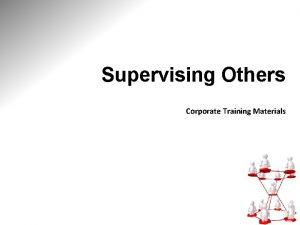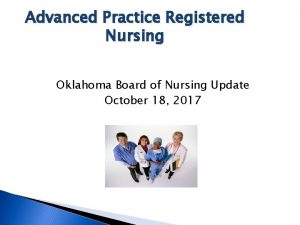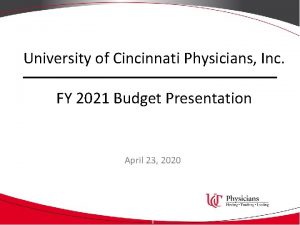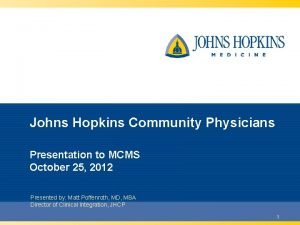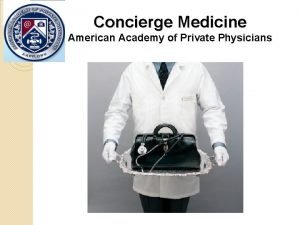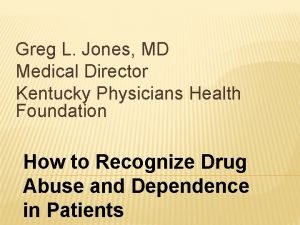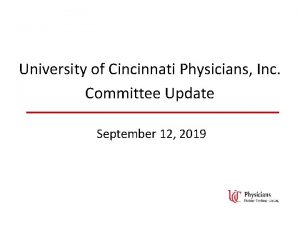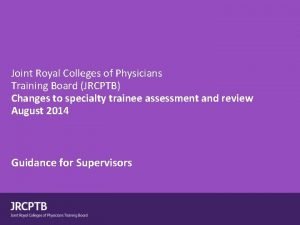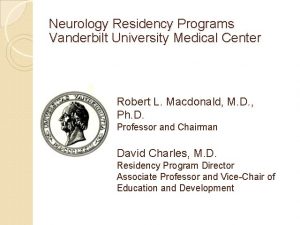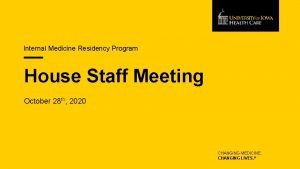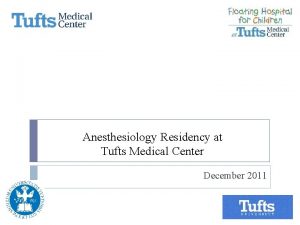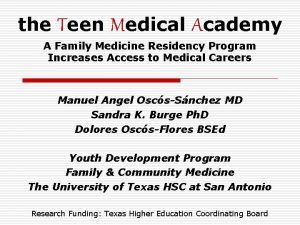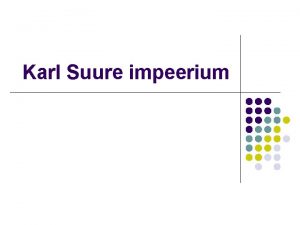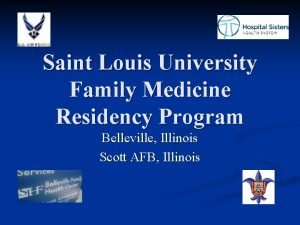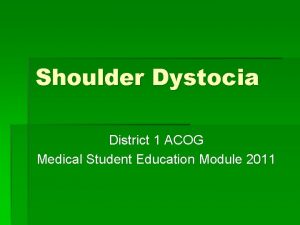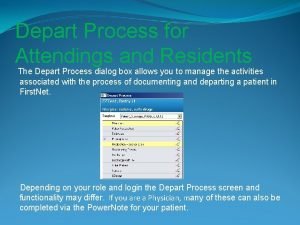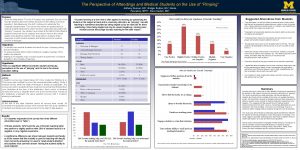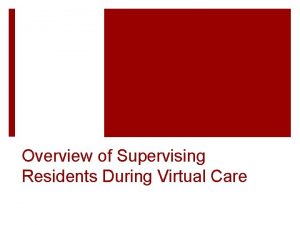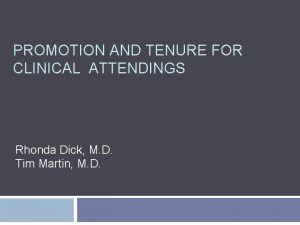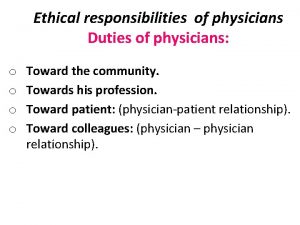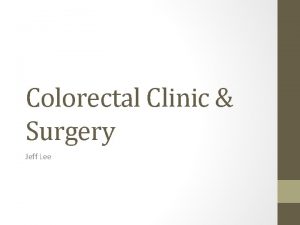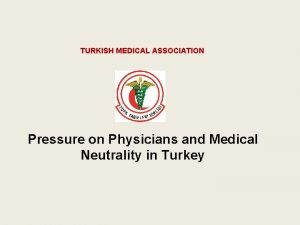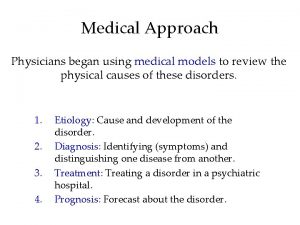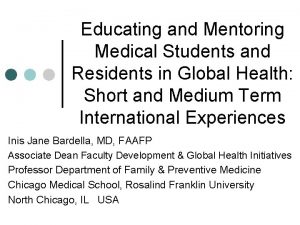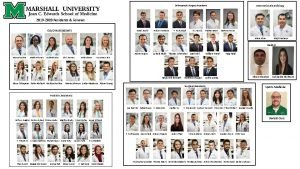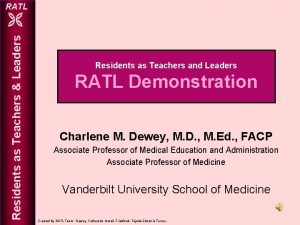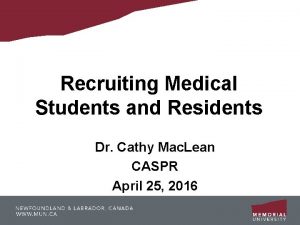Medical Students and Supervising Physicians Residents and Attendings





































- Slides: 37

Medical Students and Supervising Physicians (Residents and Attendings): An Educational Partnership The University of Cincinnati College of Medicine

First, Thank You! …for teaching our medical students. They are the future of medicine, both for our patients and for us. They will care for our loved ones, and your role as physician educator is crucial for their development.

Outline • Rationale for residents and other supervising physicians as teachers • Four primary roles of supervising physicians as teachers • Cincinnati Medicine curriculum overview • Role of supervising physician as teacher • Role of supervising physician as evaluator • Role of supervising physician as supervisor • Role of supervising physician as role model

Residents and other Supervising Physicians are Key to Medical Education College of Medicine

Rationale for Residents and Other Supervising Physicians as Teachers • Residents have the most contact with students • Increased opportunity to observe the students and to be observed by the students • Teaching is our professional responsibility • Teaching can aid our own learning

Four Primary Roles for Supervising Physicians in Medical Education • Teacher • Evaluator • Supervisor • Role model In order to do this, you need to know about our curriculum.

Cincinnati Medicine Curriculum Overview • Competencies • Curriculum and Timeline • M 3/4 Requirements • Clinical Clerkships Student Learning Outcomes

Cincinnati Medicine Program Competencies Competency Description Patient Care Provide patient-centered care that is compassionate, appropriate, and effective for the treatment of health problems and the promotion of health. Knowledge for Practice Demonstrate knowledge of established and evolving biomedical, clinical, epidemiological and social-behavioral sciences, as well as the application of this knowledge to patient care. Practice-Based Learning and Improvement Demonstrate the ability to investigate and evaluate one’s care of patients, to appraise and assimilate scientific evidence, and to continuously improve patient care based on constant self-evaluation and life-long learning. Interpersonal and Communication Skills Demonstrate interpersonal and communication skills that result in the effective exchange of information and collaboration with patients, their families, and health professionals. Professionalism Demonstrate a commitment to carrying out professional responsibilities and an adherence to ethical principles. Systems-Based Practice Demonstrate an awareness of and responsiveness to the larger context and system of health care, as well as the ability to call effectively on other resources in the system to provide optimal health care. Interprofessional Collaboration Demonstrate the ability to engage in an interprofessional team in a manner that optimizes safe, effective patient- and population-centered care. Personal and Professional Development Demonstrate the qualities required to sustain lifelong personal and professional growth. *Note these are the domains of the AAMC Physician Competency Reference Set (and slightly different than the 6 ACGME core competencies).


Cincinnati Medicine M 1/2 Requirements M 1 YEAR Requirements Foundational Courses 1. Fundamentals of Molecular Medicine 2. Fundamentals of Cellular Medicine 3. Physician and Society 4. Musculoskeletal/Integumentary 5. Brain, Mind, & Behavior M 2 YEAR Requirements Foundational Courses 1. Blood and Cardiovascular 2. Renal and Pulmonary 3. Physician and Society 4. Gastrointestinal/Endocrine/Reproduction 5. Multi-Systems Clinical Experiences Healthcare Emergency Management I Clinical Skills Longitudinal Primary Care Clerkship (LPCC) Interprofessional Collaborative Practice (IPCP) Clinical Experiences Healthcare Emergency Management II Clinical Skills Longitudinal Primary Care Clerkship (LPCC) Interprofessional Collaborative Practice (IPCP)

M 3 Clerkships and M 3 Electives Family Medicine (4 weeks total) Pediatrics (8 weeks total) • 4 weeks inpatient (night shifts, one weekend), 4 weeks outpatient • 4 weeks outpatient (no weekends) Internal Medicine (8 weeks total) • 4 weeks inpatient (4 -6 calls), 4 weeks outpatient Neuroscience (4 weeks total) • 4 weeks inpatient (one weekend) Psychiatry (6 weeks total) • 6 weeks inpatient (one weekend) Surgery (8 weeks total) • 8 weeks inpatient (8 -12 calls) Obstetrics & Gynecology (6 weeks total) • 4 weeks inpatient, 2 weeks outpatient (one weekend, one week of nights) Specialty Electives/Clerkships (two 2 week experiences)* Students must choose 2 of the following: Orthopedics, Ophthalmology, Radiology, Anesthesiology, Emergency Medicine, Geriatrics, Radiation Oncology, Otolaryngology, Pathology, MICU, CCU, Dermatology *Exposure (2 weeks) that is pass/fail (as opposed to an intensive experience); exception is Ophthalmology which is graded using Honors/High Pass/Pass categories. Use this hyperlink to find more information about M 3 rotations http: //med. uc. edu/ome/curriculum/thirdyear

Third Year Core Clinical Clerkships Student Learning Outcomes 1. Gather appropriate and accurate patient history. 2. Perform appropriate patient exam for the presenting problem/reason for visit. 3. Generate an appropriate problem-based differential diagnosis and plan. 4. Follow through on the appropriate diagnostic and therapeutic action plan. 5. Communicate patient information to the clinical team in oral form. 6. Communicate patient information to the clinical team in written form. 7. Communicate effectively with patients of diverse backgrounds (e. g. age, gender, social, racial, and economic backgrounds). 8. Demonstrate a commitment to self-directed learning by developing your knowledge outside of the traditional learning environment (e. g. demonstrate ability to retrieve and cite evidence from reliable references to advance patient care) 9. Collaborate with an interprofessional health care team (i. e. communicate with nurses, respiratory therapist, social workers, pharmacist, primary care physician, etc. ). 10. Demonstrate professional behavior in clinical setting (e. g. appearance, reliability, punctuality, motivation, commitment, and respect). The core clerkship outcomes are aligned with the Entrustable Professional Activities (EPAs) as defined by AAMC.

Cincinnati Medicine M 4 Requirements M 4 YEAR Requirements • 4 weeks Internal Medicine (IM) Acting Internship (AI) • 4 weeks Specialty AI in other specialty of choice • 4 week Internal Medicine Selective • May choose among IM subspecialties or general IM • 12 weeks of Intensive Clinical Experience (ICE) • Minimum expectation of 20 hrs/week of direct patient care • 8 weeks of general electives

Fourth Year Required Internal Medicine AI Learning Outcomes 1. Write admission orders. 2. Answer a nurse call. 3. Write a discharge summary. 4. Write a cross-cover note. 5. Give and receive patient handoffs (both in writing and verbally) to transition care responsibly. 6. Speak with specialist/subspecialist colleagues to request consultation. 7. Negotiate conflict with colleagues. 8. Deliver bad news. 9. Discuss an adverse event with a patient. 10. Obtain informed consent. 11. Gain familiarity with obtaining advanced directives and documenting DNR. 12. Review pronouncing death and filling out a death certificate.

Time Management ØPay attention to Dates! ØClick here for M 3 Dates ØClick here for M 4 Dates ØPay attention to times and demands on students! ØEnd of clerkship assessments! ØHigh stakes end of clerkship NBME subject exam testing and OSCE testing!

Key Contacts for the M 3/4 Curriculum College of Medicine

Clerkships and Clerkship Administration Know the Clerkship Director and Clerkship Coordinator first and foremost Clerkship Director / Clerkship Coordinator • Family Medicine • Dr. Robert Ellis / Nancy Jamison • Internal Medicine • Dr. Le. Ann Coberly / Julie Karpe • Neuroscience • Dr. John Quinlan / Mahima Sathe • Obstetrics & Gynecology • Dr. Andrea Hamel / Deana Brown • Pediatrics • Dr. Corinne Lehmann / Mimi Pence • Psychiatry • Dr. Peirce Johnston / Sonya Kirkland • Surgery • Dr. Krishna Athota / Bennie Patrick Click here for contact list! Use this hyperlink to find more information about clerkship administration and contact information http: //med. uc. edu/ome/curriculum/thirdyear

Cincinnati Medicine Administrative Team Office of Medical Education (OME) Provides central coordination of the curriculum and ensures all operational matters of the academic programs are compliant with accreditation standards. http: //med. uc. edu/ome • Associate Deans: • Dr. Pamela Baker • Dr. Bruce Giffin • Assistant Dean: Dr. Laurah Lukin • Director of Medical Education: Dr. Tracy Pritchard • M 1/2 Curriculum Director: Dr. Stephen Baxter • M 3/4 Curriculum Director: Dr. Robert Neel • M 3/4 Program Director: Gina Burg • Director of Electives: Dr. Amy Guiot • Director of Intersessions: Dr. Amy Guiot Offices of Medical Student Affairs & Admissions Student Affairs: Provides academic support, coordination of academic schedules, advising, financial services, and student wellness activities. • Associate Dean: Dr. Aurora Bennett • Assistant Dean: Dr. Laura Malosh http: //med. uc. edu/studentaffairs Admissions: Oversees the selection process of medical student. • Assistant Dean: Dr. Abbey Tissot https: //med. uc. edu/medicalstudentadmissions Office of Diversity, Equity & Inclusion Supports an inclusive environment for all and welcomes diversity in every aspect of daily operations. • Associate Dean: Dr. Mia Mallory • Assistant Dean: Dr. Lisa Johnson • Learning Specialist: Dr. Swati Pandya, who provides academic assistance for content knowledge deficits http: //www. med. uc. edu/diversity

Role of Supervising Physician as Teacher • Overview • Professional attributes • Cincinnati Medicine Policies • • • Principles guiding interactions between teachers and learners Duty hours Student attendance Required patient encounters and procedures Clinical supervision of students Mistreatment/harassment • Professional development opportunities in teaching and assessment

The Supervising Physician as Teacher • Set expectations for performance • This is harder than you think but crucial. What determines meeting expectations vs exceeding expectations? • Promote self-directed learning and give feedback on that learning • e. g. Encourage dissemination/discussion of scholarly articles • Teach at the bedside • Demonstrate, Observe (Direct Supervision), and Provide Feedback • Teach through the day Think Out Loud when you can. • Include a Teachable Moment • Deliver and assign “mini-lectures” and give assignments based on interest (for example, a student bound for orthopedics on IM rotation might need to know medical considerations for pre-surgical evaluation)

Professional Attributes • The following are the professional attributes that medical students are expected to develop. • Duty • Integrity • Respect • Honesty • Compassion • Fidelity • Dependability

Cincinnati Medicine Policies College of Medicine

KEY Cincinnati Medicine Policies and Procedures Click on the policy names below to view the entire policy. • Principles Guiding Interactions Between Teachers and Learners in Medicine • Duty Hours • Student Attendance • Medical Student Status Form (MSSF) • • Clinical supervision of students Required Patient Encounters and Procedures Mistreatment/Harassment Non-Discrimination and Affirmative Action All of these policies can be referenced in the Medical Student Handbook: https: //med. uc. edu/med-ed/student-handbook


Professional Development Opportunities in Teaching and Assessment • There a variety of offerings each month through the College of Medicine Office of Faculty Affairs and Development. • To view upcoming workshops, go to: http: //med. uc. edu/faculty/development

Role of Supervising Physician as Evaluator • Student levels of responsibility • Preceptor evaluation form • Policy on the Assessment of Student Performance by Faculty Healthcare Providers

Student levels of responsibility Participate: All patient encounters require students to fully participate. Participation in patient counters includes acting as the caregiver (with appropriate attending or resident supervision) of the patient on the service or clinic, aiding in a complete or problem focused history, physical, and diagnostic/therapeutic plan. This includes the ongoing management of hospitalized patients. Observe: Observation in patient encounters implies no direct patient contact (e. g. taking a history or performing a physical, participating in diagnostic/therapeutic plan for that patient). Examples might be observing another care provider providing the service (as part of team rounds) or being shown a physical exam finding on rounds.

Mechanisms for Formative Feedback for M 3 Students • Provide ongoing, regular, timely feedback, both daily and immediately after cases/patients. • Supervising physicians can provide formative feedback to students electronically using a unique QR code provided to each student. • This data will be populated to create individual dashboards for students to track their personal growth based on feedback they receive • FORMATIVE FEEDBACK DOES NOT CONTRIBUTE TO STUDENT GRADES

Providing Formative Feedback Give it a try: Scan the QR code to view the form. Note: Android users will need to download barcode scanner.

When you scan the QR code, you will see short assessments that include Likert items and a comment box for narrative feedback for that clerkship (see sample screenshots below) These items and narrative feedback are mapped back to the UCCOM program objectives

Preceptor Summative Evaluation for Students • The preceptor evaluation is a summative evaluation worth 50% of the student’s grade on a clerkship. • There are two broad categories on the Preceptor Evaluation to assess student performance: • Clinical Performance • Learning Potential • Weighting of Preceptor Summative Evaluation Scoring • 90% for items falling under “Clinical Performance” • 10% for items falling under “Learning Potential” • Click here to view or download the full version of the evaluation form. • M 3 Form • M 4 Form

Policy on the Assessment of Student Performance by Faculty Healthcare Providers • All faculty members must recuse themselves from any role in assessment, evaluation, or grading of any medical student for whom they have provided healthcare services. If assigned to assess/evaluate/ grade a student for whom a faculty has provided care, the faculty must notify the course or clerkship director as soon as is possible, of the need for reassignment and must indicate on any related evaluation forms that he/she must recuse themselves from evaluating that student. • For full policy, click here.

Role of Supervising Physician as Supervisor College of Medicine

The Supervising Physician as Supervisor • Assign patients and tasks to promote student’s learning and to integrate them into team. • Assure adequate supervision of students as they provide patient care, including performing procedures and examinations. • Direct vs Indirect Supervision. • When indirect, double check everything. • Students may not accompany monitored patients off the floor. • Co-sign notes or write “agree with” notes within 24 hours. Ask your educational team about your own documentation rules with med student notes. • Co-sign orders (when appropriate).

Role of Supervising Physician as Role Model College of Medicine

The Supervising Physician as Role Model • That which is learned through role modeling, rather than explicit teaching, through behaviors and actions. • Can be more powerful than the “explicit curriculum” of the classroom. • Be aware of professional partners in the presence of students who may not fully appreciate the difference between venting to colleagues and disparaging patients. • Also be aware of our expectations for the learning environment and for our medical students. • Students evaluate those with whom they interact on each rotation.

Thank you!
 Supervising office employees
Supervising office employees Supervising others
Supervising others Oklahoma board of nursing lpn scope of practice
Oklahoma board of nursing lpn scope of practice Ghana physicians and surgeons foundation
Ghana physicians and surgeons foundation University of cincinnati physicians inc
University of cincinnati physicians inc Retaining millennial physicians
Retaining millennial physicians Jhcp i street
Jhcp i street Maryland physician health program
Maryland physician health program The concierge academy
The concierge academy Kentucky physicians health foundation
Kentucky physicians health foundation University of cincinnati physicians inc
University of cincinnati physicians inc Wellstar physicians
Wellstar physicians Jrcptb msf
Jrcptb msf Joint royal college of physicians training board
Joint royal college of physicians training board Physicians mutual gateway
Physicians mutual gateway Wvmc mychart
Wvmc mychart The first favorite novel of rizal
The first favorite novel of rizal Michael levitt uw
Michael levitt uw Umass memorial pharmacy residency
Umass memorial pharmacy residency Vanderbilt neurology residents
Vanderbilt neurology residents Unmc obgyn residents
Unmc obgyn residents Uihc internal medicine residency
Uihc internal medicine residency Tufts anesthesia residency
Tufts anesthesia residency Dr finney unmc
Dr finney unmc Julia creider
Julia creider Informed delivery multiple residents
Informed delivery multiple residents Unm im residency
Unm im residency Uthscsa internal medicine residents
Uthscsa internal medicine residents Karl suure impeerium
Karl suure impeerium Internal tourism includes
Internal tourism includes How can an na best help residents with eating?
How can an na best help residents with eating? Demonstrate ability in personal care and safety
Demonstrate ability in personal care and safety Famous yonkers residents
Famous yonkers residents St louis family medicine residency
St louis family medicine residency Uf neurology residents
Uf neurology residents Helper shoulder dystocia
Helper shoulder dystocia Aims of health psychology
Aims of health psychology Pathology lectures for medical students
Pathology lectures for medical students

